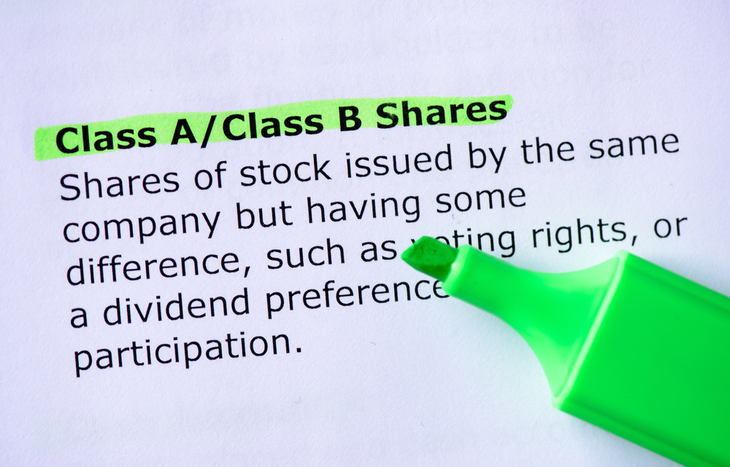What’s the Difference Between Class A and B Shares?
When buying a company’s stock, you’ll often have the option to buy Class A or Class B shares. On the surface, the difference between Class A and B shares usually comes down to price. However, looking past the sale price of stock can afford you opportunities you might not otherwise have in choosing one over the other. Are you willing to pay more for better voting rights or a higher dividend yield?
The next time you’re getting ready to invest in a company, do a cursory check of its common stock offerings to gauge the difference between Class A and B shares. Digging a little deeper below the surface price can be rewarding if you plan on being an active investor.

Shareholder Rights Stem From Share Class
Let’s say ABC Company offers Class A and Class B shares of common stock. Class A shares sell at $45 per share and Class B shares sell at $15 per share. Both are equivalent to shares in the same company… So what’s the cause for the price difference? The answer is likely shareholder rights.
Look closer at the company’s S-1 filing or at broker-provided share information and you’ll find a heavier sway of voting options in favor of the higher-priced Class A shares. In some cases, those higher-priced shares may also entitle you to a special dividend or dividend priority.
Priority shares also have benefit in the event of a merger or acquisition, or in the case of liquidation. For example, if XYZ Company acquires ABC Company in a stock deal, your Class A shares may not convert at a 1:1 ratio; rather, they’ll convert at a higher ratio to afford you more shares of the new company.
When you opt for Class A shares, you’re opting to pay for special entitlements: leveraged voting, dividend priority and priority rights in the event of M&A. if you opt for Class B shares, you still own stock in the company—it just doesn’t come with these entitlements.
Confusion Between Class A and B (and C)
It’s important to note that Class A and Class B shares aren’t always cut and dry. Some companies actually flip them, so that Class B shares feature more voting rights. Moreover, companies with Class C shares designate those as common non-voting stock, giving investors another option. It’s important to investigate a company’s S-1 to identify share structure and allocation before investing. There are no standard rules for how to structure shareholder rights across common stock share classes.
A Closer Look at Class A Shares
Class A shares actually come in several different varieties, depending on the company’s structure.
- Traditional Class A shares are held by insiders and feature leveraged voting rights. They’re not typically traded on exchanges.
- Technology Class A shares offer more voting rights, but no voting leverage. In these arrangements, Class B shares usually serve as executive shares.
- High-priced Class A shares are simply common stock with high share price, accompanied by lower-priced Class B stock with diminished voting rights.
Voting clout and priority privilege are the chief reasons to invest in Class A shares. That said, most Class A shares belong to insiders who already have more voting leverage. Moreover, technology Class A shares often don’t carry much real voting power for investors, unless they’re lumped together with an activist investor.
A Closer Look at Class B Shares
Class B shares are what most people hold in their portfolios, and what you’ll buy from your broker when you type in the ticker symbol. They tend to carry the regular 1:1 voting structure, where one share equals one vote. While they lack the priority of Class A shares, they’re also available at a discount—sometimes a heavy one.
The best example of Class B shares as a primary mode of investment is Berkshire Hathaway Inc. (NYSE: BRK.A). The company’s Class A shares trade at more than $418,000 per share—unattainable for most investors. Instead, the company’s Class B shares (NYSE: BRK.B) trade at $276. The Class B shares offer a much more reasonable point of entry for investors. While you might forgo voting rights, you gain exposure to a company that’s otherwise out of the realm of investment opportunities.
A Note About Preferred Stock
So far, we’ve been talking about common stock classes. Companies can also offer preferred stock. Preferred shares are actually a hybrid form of investment between a stock and a bond, which includes a dividend and very small movements in share price. These dividends are guaranteed, and come before any other payouts of common dividends. In the event of insolvency, preferred stock also entitles holders to a claim against liquidated assets. It is important to note, however, that preferred stock doesn’t come with any voting rights.
Does it Matter Which Shares You Hold?
Most investors will find themselves holding Class B shares of a company. What’s the difference between Class A and B shares? Price, voting rights and special dividend considerations, to name a few. For most retail investors, the difference is truly irrelevant. The difference between 100 votes and 1,000 votes is meager compared to institutional investors—firms that typically control the lion’s share of Class A shares.
To learn more about investing and the latest stock trends, sign up for the Profit Trends e-letter below. You may just find the next stock that can enhance your investment portfolio!
The real benefit for retail investors in choosing Class A shares over Class B comes down to cost and attainable benefits. If Class A shares aren’t exorbitantly expensive and the benefits go beyond voting—such as access to special dividends—it might be worth it. Consult the company’s S-1 for information about share allocation and class structure.





